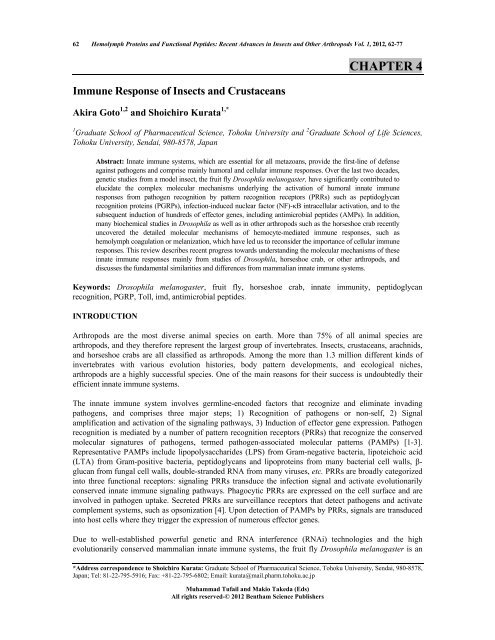chapter 1 - Bentham Science
chapter 1 - Bentham Science
chapter 1 - Bentham Science
You also want an ePaper? Increase the reach of your titles
YUMPU automatically turns print PDFs into web optimized ePapers that Google loves.
62 Hemolymph Proteins and Functional Peptides: Recent Advances in Insects and Other Arthropods Vol. 1, 2012, 62-77<br />
Immune Response of Insects and Crustaceans<br />
Akira Goto 1,2 and Shoichiro Kurata 1,*<br />
Muhammad Tufail and Makio Takeda (Eds)<br />
All rights reserved-© 2012 <strong>Bentham</strong> <strong>Science</strong> Publishers<br />
CHAPTER 4<br />
1 2<br />
Graduate School of Pharmaceutical <strong>Science</strong>, Tohoku University and Graduate School of Life <strong>Science</strong>s,<br />
Tohoku University, Sendai, 980-8578, Japan<br />
Abstract: Innate immune systems, which are essential for all metazoans, provide the first-line of defense<br />
against pathogens and comprise mainly humoral and cellular immune responses. Over the last two decades,<br />
genetic studies from a model insect, the fruit fly Drosophila melanogaster, have significantly contributed to<br />
elucidate the complex molecular mechanisms underlying the activation of humoral innate immune<br />
responses from pathogen recognition by pattern recognition receptors (PRRs) such as peptidoglycan<br />
recognition proteins (PGRPs), infection-induced nuclear factor (NF)-B intracellular activation, and to the<br />
subsequent induction of hundreds of effector genes, including antimicrobial peptides (AMPs). In addition,<br />
many biochemical studies in Drosophila as well as in other arthropods such as the horseshoe crab recently<br />
uncovered the detailed molecular mechanisms of hemocyte-mediated immune responses, such as<br />
hemolymph coagulation or melanization, which have led us to reconsider the importance of cellular immune<br />
responses. This review describes recent progress towards understanding the molecular mechanisms of these<br />
innate immune responses mainly from studies of Drosophila, horseshoe crab, or other arthropods, and<br />
discusses the fundamental similarities and differences from mammalian innate immune systems.<br />
Keywords: Drosophila melanogaster, fruit fly, horseshoe crab, innate immunity, peptidoglycan<br />
recognition, PGRP, Toll, imd, antimicrobial peptides.<br />
INTRODUCTION<br />
Arthropods are the most diverse animal species on earth. More than 75% of all animal species are<br />
arthropods, and they therefore represent the largest group of invertebrates. Insects, crustaceans, arachnids,<br />
and horseshoe crabs are all classified as arthropods. Among the more than 1.3 million different kinds of<br />
invertebrates with various evolution histories, body pattern developments, and ecological niches,<br />
arthropods are a highly successful species. One of the main reasons for their success is undoubtedly their<br />
efficient innate immune systems.<br />
The innate immune system involves germline-encoded factors that recognize and eliminate invading<br />
pathogens, and comprises three major steps; 1) Recognition of pathogens or non-self, 2) Signal<br />
amplification and activation of the signaling pathways, 3) Induction of effector gene expression. Pathogen<br />
recognition is mediated by a number of pattern recognition receptors (PRRs) that recognize the conserved<br />
molecular signatures of pathogens, termed pathogen-associated molecular patterns (PAMPs) [1-3].<br />
Representative PAMPs include lipopolysaccharides (LPS) from Gram-negative bacteria, lipoteichoic acid<br />
(LTA) from Gram-positive bacteria, peptidoglycans and lipoproteins from many bacterial cell walls, glucan<br />
from fungal cell walls, double-stranded RNA from many viruses, etc. PRRs are broadly categorized<br />
into three functional receptors: signaling PRRs transduce the infection signal and activate evolutionarily<br />
conserved innate immune signaling pathways. Phagocytic PRRs are expressed on the cell surface and are<br />
involved in pathogen uptake. Secreted PRRs are surveillance receptors that detect pathogens and activate<br />
complement systems, such as opsonization [4]. Upon detection of PAMPs by PRRs, signals are transduced<br />
into host cells where they trigger the expression of numerous effector genes.<br />
Due to well-established powerful genetic and RNA interference (RNAi) technologies and the high<br />
evolutionarily conserved mammalian innate immune systems, the fruit fly Drosophila melanogaster is an<br />
*Address correspondence to Shoichiro Kurata: Graduate School of Pharmaceutical <strong>Science</strong>, Tohoku University, Sendai, 980-8578,<br />
Japan; Tel: 81-22-795-5916; Fax: +81-22-795-6802; Email: kurata@mail.pharm.tohoku.ac.jp

















